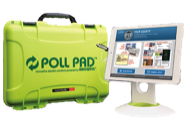
- #DEMO IMAGECAST VOTING MACHINE INSTALL#
- #DEMO IMAGECAST VOTING MACHINE UPGRADE#
- #DEMO IMAGECAST VOTING MACHINE SOFTWARE#
We can assume that it’s used on all voting computers that use flash memory. This technique was industry-standard for all kinds of equipment (not just voting machines) in the 1990s. It’s not just the AccuVote TS that installs new firmware this way.
#DEMO IMAGECAST VOTING MACHINE INSTALL#
For example, the Diebold AccuVote TS examines the ballot-definition cartridge if there’s a file present called fboot.nb0 instead of (or in addition to) the ballot-definition file, then it installs fboot.nb0 as the new bootloader! Using this mechanism, it’s easy and convenient to install new firmware, but it’s also easy and convenient to install fraudulent vote-counting programs.
#DEMO IMAGECAST VOTING MACHINE UPGRADE#
For most voting computers that use flash memory, the upgrade process is simple: install a cartridge that has the new firmware.
#DEMO IMAGECAST VOTING MACHINE SOFTWARE#
That flash memory is writable (reprogrammable) from inside the voting computer.Īlmost any kind of computer needs a mechanism to install software updates. They don’t use EPROMs to store the vote-counting program, it’s kept in flash. Voting machines designed in the 1990s and 2000s took advantage of a new nonvolatile storage technology that we now take for granted: flash memory. And in some cases it can be detected/corrected even after the election.) (What if the EMS sends fraudulent ballot definition cartridges? This should be detectable through pre-election Logic and Accuracy testing, if it’s thorough. (Then you can reprogram and reuse the old ones using an EPROM “burner” device.) Those machines are not likely hackable through the Internet, even indirectly via corrupted EMS computers. To install a new program, you need to remove the EPROM chips from the motherboard and install new ones. Voting machines designed in the 1980s ( Shouptronic, AVC Advantage, AccuVote OS, Optech-III Eagle) store their programs in EPROM (Erasable Programmable Read-Only Memory).

So how could it convey and install a new (fraudulent) vote-counting program onto the voting machine? The ballot definition is (supposed to be) just data, not a computer program. Are those EMS computers ever connected to the Internet? Most of them probably are, from time to time it’s hard to tell for sure, given the equivocations of many election administrators. If that computer is hacked, then it can prepare fraudulent ballot-definition cartridges. These cartridges are prepared on an Election Management System (EMS) computer. These files are transferred to the voting machine, before each election, by inserting a cartridge or memory card into the voting machine. But all voting machines must accept electronic input files from other computers: these “ballot definition files” tell the vote-counting program which candidates are on the ballot. Most voting machines are never plugged directly into the Internet. To hack a voting machine remotely, you might think it has to be plugged in to the Internet. The most widely used machine that fails #1 and #2 is the AccuVote TS, used throughout the state of Georgia, and in some counties in other states. touchscreens that print on paper (that the voter can inspect under glass while casting the ballot) are “in between” regarding this safeguard. Paperless touchscreen machines have no such protection. Optical scan machines, even though they can be hacked, allow audits and recounts of the paper ballots marked by the voters.Older machines ( Shouptronic, AVC Advantage, AccuVote OS, Optech-III Eagle) can be hacked by anyone with physical access newer machines (almost anything else in use today) can be hacked by anyone with physical access, and are vulnerable to attacks from the Internet.Which voting machines have other safeguards, so we can audit or recount the election to get the correct result even if the machine is hacked?.Which voting machines can be hacked from anywhere in the world, through the Internet?.It’s a general principle about computers: they run whatever software is installed at the moment. I’ve demonstrated this on one kind of machine, others have demonstrated it on other machines. An attacker with physical access to a voting machine can install fraudulent vote-miscounting software.

Which ones of them can be hacked to make them cheat, to transfer votes from one candidate to another? run elections with a variety of voting machines: optical scanners for paper ballots, and direct-recording “touchscreen” machines. Over 9000 jurisdictions (counties and states) in the U.S.

This article was originally published at Freedom to Tinker on September 20, 2016.


 0 kommentar(er)
0 kommentar(er)
